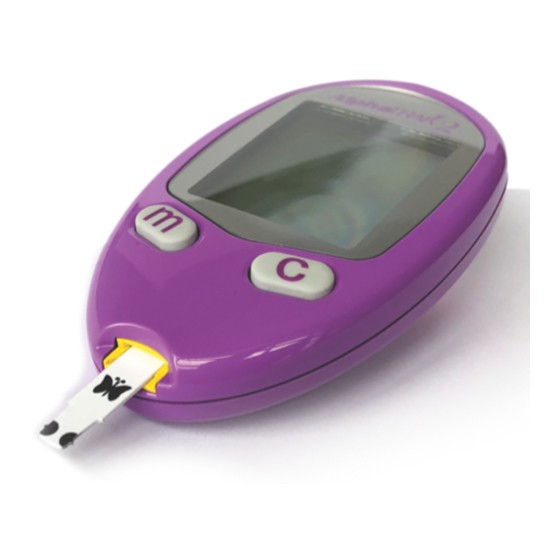Table of Contents
Advertisement
Quick Links
We're here to help.
Click on a topic to jump directly to that section.
The Meter
The Lancing Device
Getting a Blood Sample
Understanding Results
WHY TEST YOUR PET'S BLOOD GLUCOSE AT HOME?
At-home blood glucose testing is an accurate way to
monitor your pet's diabetes.
It provides accurate data for your veterinarian to make
informed treatment decisions.
It identifies low blood glucose levels immediately:
no waiting for a clinic visit.
It can save you time and money, and it can save you and your pet stress.
WHAT COULD AFFECT YOUR PET'S BLOOD GLUCOSE LEVELS?
If you see a spike or dip in your pet's blood glucose reading,
don't panic. It could be normal or just the result of:
Exercise
Eating or having a treat
A visit to the veterinarian
Kids or company in the home
Excitement, like chasing a squirrel or mouse
Stress, fear or anxiety
If your pet is showing signs of a diabetic complication,
contact your veterinarian.
1
Advertisement
Table of Contents

Summary of Contents for Zoetis AlphaTRAK 2
- Page 1 We’re here to help. Click on a topic to jump directly to that section. The Meter The Lancing Device Getting a Blood Sample Understanding Results WHY TEST YOUR PET’S BLOOD GLUCOSE AT HOME? At-home blood glucose testing is an accurate way to monitor your pet’s diabetes.
- Page 2 Apply blood to the test strip before inserting strip into meter. Get blood into the test strip port. Use strips other than those made for AlphaTRAK 2. DON’T GIVE UP! This might take a little practice, but you’ll be a pro in no time.
- Page 3 The Lancing Device Getting A Blood Sample Understanding Results T H E M E T E R Turning Meter On and Off and Checking Codes. BEFORE TURNING METER ON: Check the expiration code on the test strip vial. DO NOT USE EXPIRED STRIPS. A.
-
Page 4: Adjusting Depth
The Meter Getting a Blood Sample Understanding Results T H E L A N C I N G D E V I C E Lancing Device Do’s and Don’ts DO... Prepare the lancing device before approaching your pet for a blood sample. Make sure the meter is set and ready prior to getting a blood sample. -
Page 5: G E T T I N G A B L O O D S A M P L E
Familiarize your pet with the sound of the lancing device. Hold the device close to your pet’s ear and press the button a few times before performing the test the first time. Contact your veterinarian’s office or Zoetis for help if you cannot obtain a successful test after three attempts. - Page 6 The Meter The Lancing Device Understanding Results G E T T I N G A B L O O D S A M P L E (CAPILLARY SAMPLING) 1. dog ear location with lancing device 2. dog elbow callous with lancing 3.
-
Page 7: Record Results
The Meter The Lancing Device Understanding Results G E T T I N G A B L O O D S A M P L E (CAPILLARY SAMPLING) 1. Prepare the Testing Site 5. Add More Blood to Test Strip if Needed Gather all the supplies needed to perform a test. - Page 8 The Meter The Lancing Device Getting a Blood Sample U N D E R S T A N D I N G R E S U L T S COMMUNICATING RESULTS TO YOUR VETERINARIAN Your veterinarian uses the results of the blood glucose test you take to monitor and adjust your pet’s treatment plan.
- Page 9 1. Behrend E, Holford A, Lathan P, et al. AAHA diabetes management guidelines for dogs and cats. J Am Anim Hosp Assoc 2018; 54: 1-21. DOI: 10.5326/JAAHA-MS-6822. All trademarks are the property of Zoetis Services LLC or a related company or a licensor unless otherwise noted. © 2018 Zoetis Services LLC. All rights reserved. ATK-00201...









Need help?
Do you have a question about the AlphaTRAK 2 and is the answer not in the manual?
Questions and answers